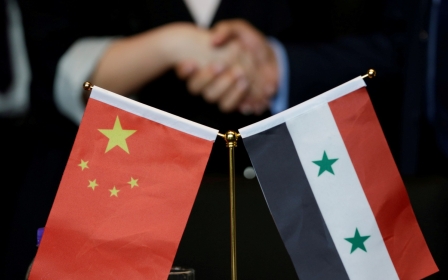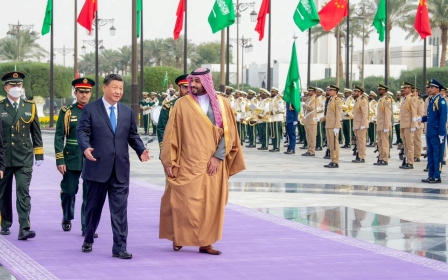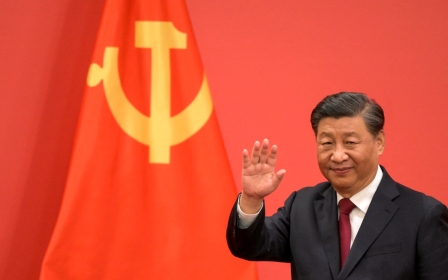Saudi-Iran deal: Can China end proxy wars in the region?

The re-establishment of diplomatic relations between Saudi Arabia and Iran announced on 10 March, and the meeting of their foreign ministers on 6 April has raised expectations of a lasting peace in the Middle East.
The two countries have fought proxy wars in Syria, Iraq, Lebanon and Yemen and maintained a fierce geopolitical contestation for influence in the region.
By providing the platform for the agreement and acting as a mediator, China has effectively stepped in where the US has previously failed.
But there are still a number of notable challenges that could undermine peace between Riyadh and Tehran, and diminish the region’s prospects of a lasting peace. Key amongst these challenges are the proxy wars in the Middle East that have claimed hundreds of thousands of lives.
From the ruins of such conflicts, armed non-state actors have emerged as important players who will have a decisive say over the future of the region, and can either enable or spoil the fragile peace between Saudi Arabia and Iran.
From proxies to statesmen
The past decade has seen Middle Eastern and Western powers pour vast resources into cross-border proxy conflicts.
One of the fundamental and enduring features of the character of warfare is the role and proliferation of both proxy wars and armed non-state actors.
Hastened - but not enabled - by the 2003 US-led invasion of Iraq, and then intensified by conflicts in Syria, Libya and Yemen after the Arab Spring, proxy warfare has radically transformed governance and security structures in the Middle East.
Proxy wars tend to be inherently protracted, owing to the organisational structure of its non-state belligerents and the involvement of outside actors. The latter increases the durability of such conflicts: outside powers can provide non-state actors with material support such as arms and money and, yet, at the same time deny involvement. This reduces the pressure on states to end their involvement in such wars but allows them to continue to pursue their geopolitical aspirations.
Moreover, it is only when all parties perceive their involvement as offering limited returns and intolerable costs that they contemplate either ending their involvement or becoming more amenable to a settlement - and it remains to be seen whether this applies to Saudi Arabia and Iran.
As the conflicts in Syria and Yemen, among others, highlight, conflict can endure for almost a decade, despite repeated efforts to establish a negotiated end. The notion of a lasting settlement is in itself a difficult concept in the case of civil wars.
The second-order effects of conflicts are often understated: this includes their impact on the public consciousness and the collective memories of injustice and repression they create, and that establish the grievances and conditions for conflict relapse.
These conditions add to the resilience of armed non-state actors.
For the most established groups, such as Iraq’s Asaib ahl al-Haq and Yemen’s Houthis, the bloodletting that has gripped the region since the 2011 Arab uprisings provided an opportunity to swell their ranks.
Groups such as Hezbollah, meanwhile, expanded their cross-border reach by deploying and supervising fighters to Syria and Iraq.
For the groups that emerged or organised in response to the post-Arab Spring Middle East, such as Iraq’s Popular Mobilisation Force (PMF) - which was established in the wake of the war on IS in 2014 - or Hay'at Tahrir al-Sham (HTS) in Syria, which formed in 2017 - proxy wars and material support from external sponsors opened up the opportunity to transition from rag-tag militias to battle-hardened, resource-rich and organisationally disciplined socio-political actors.
Fundamentally, armed groups have started to re-fashion the state and its institutions according to their own ideological outlook and political objectives. In Iraq, the PMF has secured parliamentary seats, has access to a $2bn budget, and functions as an auxiliary of the Iraqi armed forces.
It has even established its own state-sanctioned commercial company with an operating budget of at least $67m. Others, such as the Kurdish People's Protection Units (YPG), which controls oil resources in northeastern Syria and HTS in Syria, which governs through the Syrian Salvation Government, as well as a plethora of Iran-aligned groups, which control areas south of the Euphrates river in Deir Ezzor, present challenges for regional security.
This was markedly portrayed by the escalation this week between Turkey and the Syrian Democratic Forces (SDF), and the tit-for-tit military confrontation between the US and Iran last month.
Armed groups as spoilers
This week, Saudi and Omani envoys arrived in Yemen's capital Sanaa to negotiate a permanent ceasefire deal with Houthi officials and end an eight-year-old conflict there.
However, the notion of an inter-state-driven peace process focused on ending proxy wars can be problematic if it attempts to sideline the actors or understates their resilience and resistance to change and, crucially, their capacity to act as spoilers.
Israel and Iran, for example, are engulfed in a shadow war that produces reveberations in Lebanon, Syria and Iraq.
In Yemen, the Southern Transitional Council (STC), backed by the United Arab Emirates as part of the Saudi-led coalition, has already said it will not be bound by an agreement between Saudi Arabia and its Houthi rivals. In Lebanon, the Saudi backed Lebanese Forces Party and Iran-backed Hezbollah have both expressed scepticism that the Saudi-Iran agreement will end Lebanon's presidential stalemate.
The complex peace-building
Fundamentally, it is difficult to envisage a scenario where Iran will de-mobilise or reign in its allies, not when they have had a transformational impact on Iran’s projection of power in the region.
In Syria alone, Iran has mobilised and continues to supervise tens of thousands of Hezbollah fighters and other fighters from Iraq, Pakistan and Afghanistan, who fought alongside the Syrian regime to defeat the rebels and end the uprising.
Beijing is entering unchartered territory where armed non-state actors exercise greater authority and legitimacy, and can determine the contours of peace in the region
China has put its credibility on the line by functioning as a guarantor of peace between Saudi Arabia and Iran.
Beijing is entering unchartered territory where armed non-state actors exercise greater authority and legitimacy, and can, therefore, determine the contours of peace in the region. Here, Beijing lacks the institutional experience and track-record for managing the complexities of peace-building.
Such complexities are only really addressed, in the long-term, through security reform and good governance, processes that mitigate the far-reaching political and humanitarian implications that armed groups and the war economy present. While these constitute essential parts of Western engagement with the region, it is unclear if China will follow suit.
The views expressed in this article belong to the author and do not necessarily reflect the editorial policy of Middle East Eye.
This article is available in French on Middle East Eye French edition.
Middle East Eye propose une couverture et une analyse indépendantes et incomparables du Moyen-Orient, de l’Afrique du Nord et d’autres régions du monde. Pour en savoir plus sur la reprise de ce contenu et les frais qui s’appliquent, veuillez remplir ce formulaire [en anglais]. Pour en savoir plus sur MEE, cliquez ici [en anglais].






